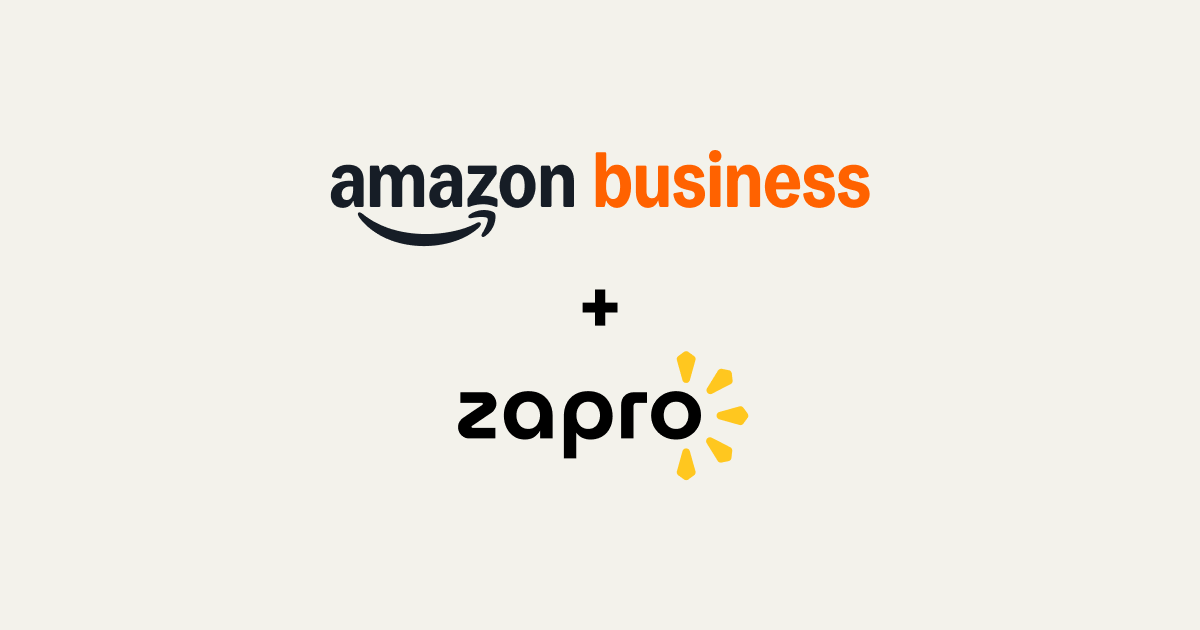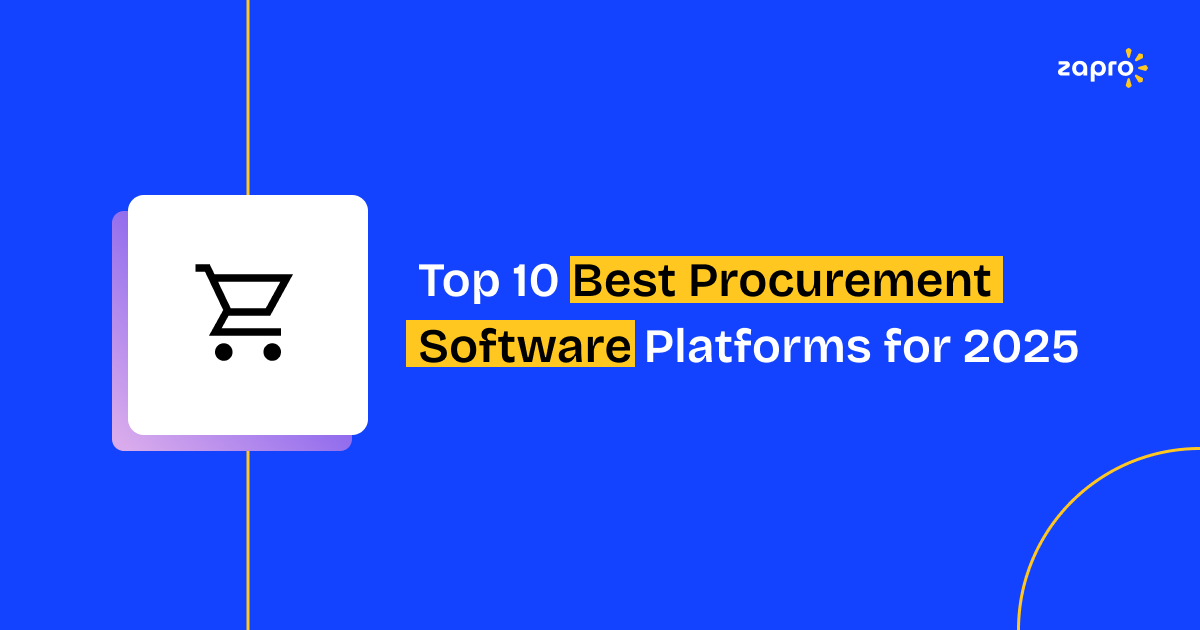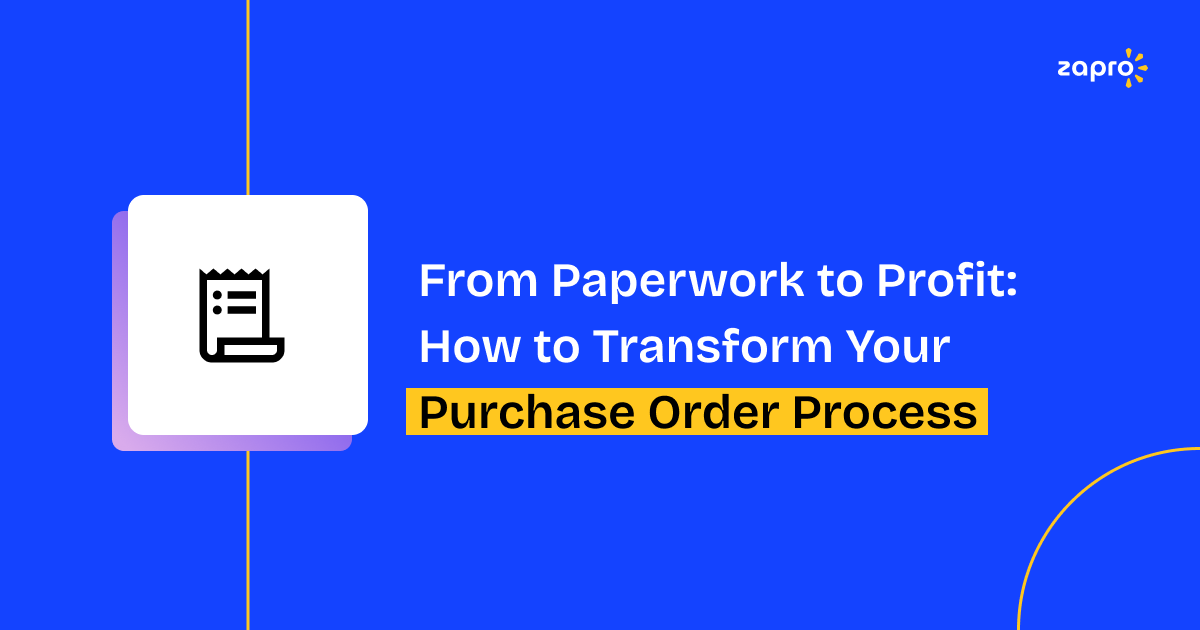What is e-procurement software?
E-procurement software helps businesses manage everything related to buying goods and services—from sourcing suppliers to making payments—all in one digital system. It replaces outdated, manual processes with a faster, more organized way to handle procurement tasks.
With e-procurement software, teams can:
- Create and approve purchase requests online
- Set up rules to control spending and ensure compliance
- Get real-time visibility into budgets, suppliers, and contract status
- Cut down on unauthorized purchases and slow approval cycles
- Work more easily with suppliers using built-in collaboration tools
But e-procurement isn’t just about improving day-to-day operations. As supply chains get more complex and cost pressures rise, procurement teams are expected to do more than just place orders—they’re expected to deliver real business value.

“There has been a continuous evolution of e‑procurement software… while adoption by businesses… still significantly lags behind the pace of adoption in our personal lives.”
-Simon Whatson
That’s where e-procurement software makes a difference. It helps teams:
- Use data to make better sourcing decisions
- Track supplier performance over time
- Connect with ERP or analytics systems for full visibility
- Align with broader goals like ESG, cost savings, and risk management
Whether you’re a procurement lead trying to cut back on manual work or a finance exec looking for tighter spend control, the right e-procurement tool can give you a big advantage.
In this guide, we’ll break down some of the top-rated e-procurement platforms—so you can find the one that fits your needs, budget, and where your procurement function is headed.
Key takeaways
- E-procurement software revitalizes the procurement process, efficiently guiding processes from sourcing to payment while ensuring seamless collaboration between buyers and suppliers.
- These e-procurement systems offer impressive cost savings, eradicate the need for excessive paperwork, and guarantee the timely execution of procurement tasks, thus avoiding costly delays.
- Transparency and compliance get a substantial boost, with audit trails and rule-based workflows that mitigate risks and secure adherence to regulatory standards.
- E-procurement systems empowers procurement experts, delivering them actionable insights to heighten productivity and cultivate robust supplier relationships.
- Choosing the right e-procurement software is crucial, with important factors including user-friendliness, compatibility with existing systems, comprehensive analytics, and flexibility to meet evolving business needs.
7 Key Benefits of an E-Procurement System
Procurement is no longer just about placing orders—it’s about creating value, driving savings, and aligning with broader business goals. That’s why more companies, from startups to global enterprises, are moving to modern e-procurement software.
Whether you’re exploring procurement software for small business or an enterprise-grade platform like Zapro, here are the seven most important benefits you should expect:
1. Cost Efficiency Without the Complexity
Old-school ERP systems come with steep setup fees and long implementation timelines. In contrast, today’s cloud-based digital procurement solution offer:
- Affordable subscription pricing
- Low IT overhead (no servers or hardware)
- Quick deployment and faster ROI
More importantly, they help you control spend at scale—by eliminating rogue purchases, identifying cost-saving opportunities, and tracking every dollar. That’s a win for your procurement KPI performance and your CFO’s bottom line.
2. No More Paper Trails or Scattered Systems
Paper forms, email chains, and disconnected spreadsheets create chaos. A modern e-procurement system brings everything—from purchase requests to Goods Received Notes—into one digital hub. With this:
- Teams avoid duplication and manual errors
- Finance and procurement stay in sync
- Audit prep becomes simple with clear transaction histories
And since it connects seamlessly to your ERP or procure to pay process, you get clean, real-time data across the board.
3. Timely Contract and Task Management
Missed deadlines on contract renewals, vendor assessments, or budget approvals can quietly erode your procurement performance. E-procurement tools solve this with:
- Automated reminders for expiring contracts or key milestones
- Built-in calendars and task alerts for procurement activities
- Streamlined workflows that reduce bottlenecks
This helps avoid disruption, ensures compliance, and strengthens supplier trust—key when managing multiple vendors or facing common procurement challenges.
4. Built-In Controls for Transparency and Compliance
E-procurement tools don’t just digitize workflows—they enforce discipline. With configurable rules, you can:
- Set approval limits based on role or budget
- Track every decision made (who approved what, when, and why)
- Reduce risk of unauthorized spending or biased supplier selection
This makes procurement audit-ready by default and ensures you stay aligned with internal policies or external regulations—a must in industries like finance, healthcare, or government.
5. Increased Productivity Across the Board
User-friendly design isn’t a nice-to-have—it’s essential. With intuitive interfaces, self-serve catalogs, and mobile access:
- Employees can submit and track requests on their own
- Procurement teams spend less time on back-and-forth emails
- Supplier onboarding becomes faster with integrated Vendor Management Tools
That means fewer delays and more time to focus on strategic sourcing, supplier development, or negotiations.
6. Real-Time Data for Smarter Procurement Decisions
Procurement is becoming more data-driven—and the right software gives you analytics that go far beyond spreadsheets. Expect:
- Custom dashboards showing category spend, supplier performance, and pricing trends
- Insights that support smarter sourcing, budgeting, and forecasting
- Data you can use to optimize your procurement strategy and track progress across the entire procurement life cycle
This is how procurement shifts from reactive to proactive—and from operational to strategic.
7. Better Collaboration with Suppliers
Strong supplier relationships aren’t built in emails or spreadsheets. E-procurement platforms include supplier management software features like:
- Centralized communication threads and shared dashboards
- Vendor scorecards and feedback loops
- Portals for document exchange, performance tracking, and updates
The result?
Faster responses, better alignment on goals (like ESG or delivery quality), and more opportunities for innovation.
Learn more about Top Affordable Purchasing Software for Small Businesses in 2025
11 Must-Have Features in E-Procurement Software
Choosing the right e-procurement software isn’t just about automation—it’s about enabling smarter, faster, and more compliant procurement decisions across the organization. With an increasing emphasis on spend visibility, strategic sourcing, and digital transformation, your procurement tool must go beyond the basics.
Whether you’re comparing solutions for enterprise use or procurement software for small business, here are 11 non-negotiable features to look for:
Intuitive User Experience (UX)
Adoption is key. The best procurement tools are designed with clean interfaces, guided workflows, and user-friendly dashboards. This reduces training time and encourages consistent use across departments—especially important in managing the full procurement life cycle.
Seamless Integration with Existing Systems
Your e-procurement solution should integrate effortlessly with ERP platforms, finance systems, and other tools. This ensures uninterrupted workflows and accurate data exchange—critical in optimizing the procure to pay process.
Advanced Data Analytics
Analytics go beyond reporting—they power decision-making. Look for solutions that provide real-time dashboards, supplier scorecards, and trend forecasting. These capabilities help measure and track key procurement KPIs to identify savings opportunities and risks.
Customizable and Adaptable Workflows
One-size-fits-all rarely works in procurement. Leading solutions let you configure approval hierarchies, compliance gates, and category-specific workflows to address your organization’s unique procurement challenges.
Enterprise-Grade Security and Compliance
Procurement data is sensitive—from contracts to financials. Your software must include:
- Multi-factor authentication
- Role-based access controls
- Automated audit logs
- Compliance with standards like SOC 2 or ISO 27001
These features support governance, reduce risk, and align with corporate or industry mandates.
Mobile Accessibility
Remote work and global supply chains require agility. A mobile-friendly e-procurement platform allows users to:
- Approve purchase orders
- Review Goods Received Notes
- Access contracts or reports on the go
This boosts responsiveness and supports a decentralized procurement model.
Scalability for Growth
As your company expands, so should your software. Choose a solution that scales easily in terms of users, suppliers, and categories—without re-platforming. This is especially vital for fast-growing businesses transitioning from tactical buying to a more strategic procurement strategy.
Collaboration Tools and Supplier Portals
Streamlined collaboration—both internal and external—is foundational. Features like in-app messaging, shared RFQ spaces, and supplier management software portals help:
- Reduce back-and-forth emails
- Centralize document sharing
- Improve cross-functional alignment
Real-Time Reporting
Procurement doesn’t operate on static data. Real-time status updates on pending approvals, supplier responses, or budget utilization help teams act faster and avoid bottlenecks—especially during month-end close or compliance reviews.
Learn more about Best Procurement Software Platforms For 2025
Automated Compliance and Policy Enforcement
The best tools don’t just track compliance—they enforce it. Features to look for include:
- Rule-based validations during requisition creation
- Contract auto-matching on invoicing
- Policy reminders embedded in workflows
This ensures audit-readiness and reduces manual compliance burdens.
- Training, Support, and Onboarding Resources
Even the most powerful software can fall short without proper adoption. Top vendors provide:
- Step-by-step onboarding
- On-demand training modules
- Responsive customer success teams
This support is essential for a smooth transition—especially when rolling out a new vendor management system across departments.
Top 7 E-Procurement Tools for Your Business
Finding the right e-procurement software isn’t just about picking a tool—it’s about choosing a long-term partner that can help you streamline operations, reduce costs, and improve vendor collaboration. Whether you’re a growing business looking for agility or a large enterprise needing scale and control, the right platform can make a real difference.

We’ve put together a list of seven top-rated e-procurement solutions based on real user feedback, ease of use, core features, and how well they support the entire procurement life cycle.
Let’s take a closer look at what makes each of them stand out.
1. Zapro
Zapro is a modern, cloud-native procurement software built to meet the evolving needs of agile, digitally-driven businesses. Designed with flexibility at its core, Zapro goes beyond automation—it empowers teams to manage end-to-end procurement while aligning spend with strategy.
Why it stands out:
Zapro combines intuitive design with powerful features like AI-driven analytics, smart sourcing, and integrated vendor management tools. It’s ideal for businesses seeking speed, transparency, and smarter procurement decisions.
- Pros:
- Embedded supplier management software for unified collaboration
- Predictive analytics for spend forecasting and optimization
- Lightning-fast deployment and low learning curve
- Cons:
- Advanced customization may require vendor-side support
Rating: 4.8/5 (Gartner)
Best for: Organizations prioritizing rapid digital transformation and AI-driven procurement strategies
Your Procurement Transformation Starts Here

2. Coupa
Coupa is a global leader in procurement solutions for enterprises looking to drive savings, compliance, and spend visibility. It’s known for its user-centric design and holistic approach to procure to pay process management.
Why Coupa stands out:
Coupa offers deep spend analysis, strong supplier engagement features, and easy integration with ERP systems—making it a powerful tool for procurement leaders aiming to track performance against key Procurement KPIs.
Pros:
- Highly scalable for growing businesses
- Exceptional real-time spend analytics and policy enforcement
Cons:
- Pricing may not suit small to mid-sized companies
Rating: 4.5/5 (Capterra)
Best for: Large enterprises focused on compliance, governance, and enterprise-grade spend control
Bonus Insight: Coupa’s built-in tools for tracking Goods Received Notes and contract lifecycle events make it an excellent choice for organizations with complex sourcing workflows.
3. SAP Ariba
SAP Ariba brings together procurement, supply chain, and contract management on a global scale. Known for its ability to handle high volumes and international workflows, Ariba is a staple in enterprise digital transformation initiatives.
Why it stands out:
Ariba’s deep functionality across sourcing, contract management, and spend analysis makes it suitable for global organizations requiring robust vendor management systems and supply chain collaboration.
Pros:
- Global network of suppliers supports international sourcing
- End-to-end integration with SAP ERP systems
Cons:
- Lengthy implementation and IT resource requirements
Rating: 4.3/5 (G2)
Best for: Multinational corporations with complex procurement and compliance needs
Bonus Insight: SAP Ariba is well-suited to companies managing multi-tiered procurement processes and layered supplier risk across regions.
4. Kissflow
Kissflow focuses on simplicity and automation, making it a strong contender for organizations that want to streamline purchase requisitions and approvals without overwhelming users. Its minimalist design encourages adoption across teams, effectively reducing bottlenecks in the procure to pay process.
Why it stands out:
Its intuitive interface and powerful workflow automation eliminate manual steps, enabling faster purchase cycle times and reducing human errors—essential for overcoming common procurement challenges like process delays and compliance risks.
- Pros:
- Easy-to-use platform drives faster onboarding
- Effective workflow automation supports compliance and audit trails
- Cons:
- Lacks deep analytics, so businesses needing advanced reporting may require additional BI tools
- Rating: 4.6/5 (Software Advice)
- Best for: Small to mid-sized businesses or teams focused on tactical procurement efficiency and process digitization
5. Oracle Procurement Cloud
Oracle Procurement Cloud offers an enterprise-grade, unified procurement platform designed to manage every aspect of the procurement life cycle. It delivers deep enterprise intelligence and analytics, helping organizations optimize spend, enforce compliance, and align purchasing with strategic goals.
Why it stands out:
With strong AI-driven insights and a comprehensive suite of procurement tools, Oracle empowers large enterprises to centralize procurement activities and enhance supplier collaboration through its vendor management system.
Pros:
- Full suite covering sourcing, contract, supplier, and spend management
- Scalable for global enterprises with complex procurement ecosystems
Cons:
- Steeper learning curve demands thorough training and onboarding support
Rating: 4.4/5 (TrustRadius)
Best for: Enterprises with mature procurement functions seeking integrated procurement software that supports strategic decision-making and compliance
6. Jaggaer
Jaggaer specializes in advanced strategic sourcing and supplier engagement, offering real-time analytics to enhance supplier relationships and procurement efficiency. It is especially strong in sectors that require rigorous supplier risk management and value-driven procurement strategies.
Why it stands out:
Jaggaer’s focus on supplier relationship management—powered by comprehensive supplier management software—helps companies build long-term partnerships and improve supplier performance visibility.
Pros:
- Strong supplier collaboration tools and sourcing optimization
- Useful real-time analytics for spend and supplier risk insights
Cons:
- Limited third-party integrations can challenge seamless tech ecosystem integration
Rating: 4.1/5 (GetApp)
Best for: Mid-sized to large enterprises emphasizing supplier partnerships and strategic sourcing
7. Ivalua
Ivalua is a highly customizable source-to-pay platform designed to support diverse and complex procurement strategies. It offers comprehensive features that enable procurement teams to innovate and tailor workflows, contracts, and supplier engagement processes.
Why it stands out:
Its flexible architecture makes it ideal for organizations that require customization and innovation to address unique procurement needs, from compliance to sustainability goals.
Pros:
- Extensive feature set with high customizability
- Supports complex procurement strategies and diverse supplier ecosystems
Cons:
- Performance may slow down with very large datasets, impacting real-time efficiency
Rating: 4.2/5 (FinancesOnline)
Best for: Organizations with complex, bespoke procurement requirements seeking a fully adaptable platform
How Zapro is Different from Other E-Procurement Software
Choosing an e-procurement tool isn’t just about handling purchase orders and invoices anymore. You want something that actually helps you build better vendor relationships and makes your life easier. That’s where Zapro shines.
Here’s why Zapro’s a game-changer:
- It’s all about vendor relationships, not just transactions. Zapro tracks every interaction—emails, calls, notes—so you always have the full picture and nothing falls through the cracks.
- Everything in one place. No more juggling a dozen different systems. Zapro brings all your vendor management tasks under one roof, making it easier to stay on top of things and make quick decisions.
- Faster onboarding and big savings. Zapro cuts vendor onboarding time in half and helps save you over 30% by cutting out wasted time and hidden costs.
- Risk management built-in. No need for separate tools—Zapro keeps an eye on supplier risks so you can spot problems early and avoid surprises.
- Simple, team-friendly interface. It’s designed for collaboration, so your whole procurement team can work together smoothly from start to finish.
If you want to move beyond basic procurement and turn vendor management into a real competitive edge, Zapro is the tool for you.

Kickstart Your Smarter Procurement Journey
Don’t miss our weekly updates
We’ll email you 1-3 times per week—and never share your information.

 Healthcare
Healthcare Financial Services
Financial Services Technology
Technology Venture Capitalist
Venture Capitalist Chief Procurement Officer
Chief Procurement Officer Chief Financial Officer
Chief Financial Officer




